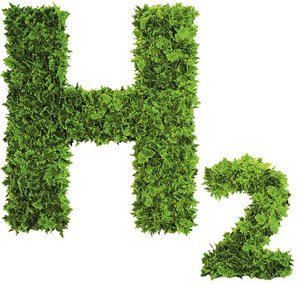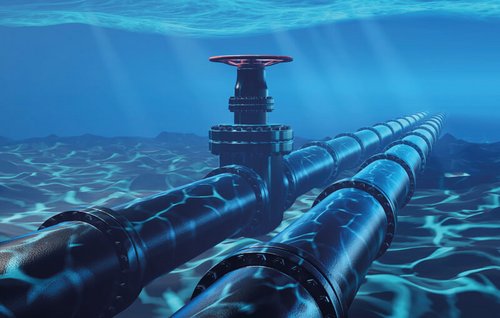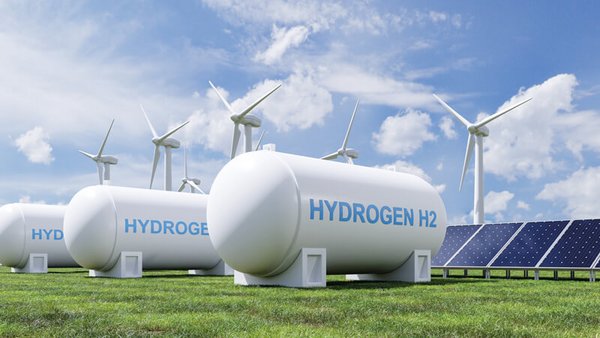Green hydrogen – new opportunities for sustainable development in the Global South?
Hydrogen is the lightest and most common element in the universe. However, most of the hydrogen on Earth is bound up with oxygen, as part of water. To be used as an energy carrier, free hydrogen molecules are needed. Traditionally, and at very large scale, free hydrogen – used in the chemical industry, including ammonia production and in refineries – is obtained through a process called steam methane reforming (SMR), which uses hydrocarbons – most often natural gas – and extracts hydrogen in a series of chemical reactions. This method requires large amounts of energy, as the reforming reactor has to be kept at very high temperatures to keep the chemical processes running. The high energy demand adds to the carbon dioxide produced from the natural gas reactions and makes SMR a heavy emitter of greenhouse gases. It is estimated that 9.3 kilograms (kg) of CO2 are generated per kg of hydrogen produced with SMR, more than an equivalent amount of gasoline, which produces 9.1 kg of CO2 when combusted. The hydrogen obtained in this way is called grey hydrogen. In Germany, 55 terrawatt-hours (TWh) of grey hydrogen are annually processed, mainly in the petrochemical industry. Grey hydrogen only contributes to decarbonising industries and other societal processes if the CO2 produced is captured and not emitted into the atmosphere. The hydrogen coming out of this low-carbon process is labelled as blue hydrogen.
The vision of an international green hydrogen economy
For some years now, hope has rested on hydrogen produced without emissions – also called green hydrogen (GH2). Here, the starting material is simply water, and the splitting into its two components is done by electrolysis, a process of which the chemical principles have been well-known for more than 200 years. In producing H2, the energy required for electrolysis is exclusively gained from renewable energies. Against the background of international commitments to rapidly reduce greenhouse gas emissions (GHG) and achieve zero carbon societies in a few decades, a steep increase in low-carbon hydrogen demand in the industrialised world is expected.
In addition to using hydrogen (or synthetic fuels, which are often derivatives of hydrogen), there is also the option of direct electrification as a way to decarbonise industrial processes. With regard to some applications, the two approaches are competing to become the dominant technology. It is, however, very clear that hydrogen will play a crucial role in all industrial processes which require high amounts of process heat, e.g. the steel- and metal-processing and glass industries. This demand arises mainly in the Global North. It is expected that Europe, Japan and South Korea in particular will have to import a great deal of green hydrogen in order to achieve their climate targets. They host many emission-intensive industries but lack renewable energy potentials and space to generate high amounts of green hydrogen.

Photo: Dragon Claws/ Adobe Stock
At the same time, the transition towards green hydrogen is seen as a potential for sustainable development in the Global South. Many developing countries in Africa, Latin America and Asia are endowed with very large potentials of solar radiation, wind and – sometimes – geothermal energy. These comparative advantages could help to open market opportunities in the North. Whether and how these opportunities can in fact trigger more sustainable development patterns in the developing world is still “work in progress”. We will come back to this later. First we must analyse some uncertainties and risks which may hamper or at least delay the ramp-up of a green hydrogen world economy.
Techno-economic and systemic uncertainties of scaling up GH2
In the past two to three years, the hydrogen topic “went viral” across the globe. More than 20 countries and the European Union approved national hydrogen strategies since 2020. Taking together, these combine more than 50 per cent of the world's economic output. More policy papers are in the pipeline. Some of these strategies are extremely ambitious, with regard to hydrogen production, trade and usage. The EU, for instance, projects 40 gigawatts (GW) of electrolyser capacities to be up and running already by 2030, producing around 10 megatons of hydrogen per year. A simple comparison makes the level of ambition clear. Since 2021, Europe’s largest electrolyser has been operated by the Shell company at its chemical park in Wesseling, close to Cologne in Germany. It has a capacity of 10 MW (= 0.01 GW) and is expected to annually produce 1,300 tons of green hydrogen. Thus, for achieving the ambitions of green hydrogen strategies it has to be assured that electrolysing capacities can be scaled up from pilot scale facilities to large industrial plants in a few years. This includes establishing supply chains for raw materials, sometimes of scarce supply on the world markets, e.g. iridium in the case of Proton Exchange Membrane (PEM) electrolysers.
Iridium is an extremely rare metal. Annually, not more than seven metric tons is extracted, mostly as a by-product of nickel and copper mining or, alternatively, while isolating platinum from its ores. There is a concentration of iridium production in South Africa, which holds 70 per cent of the global market. For the very steep increase in electrolyser manufacturing, global production must be rapidly expanded and/or the iridium context of PEM electrolysers reduced via technological innovations. Alternative technologies, such as alkaline electrolysers, provoke fewer bottlenecks, but are less suited to work with intermittent renewable energies.
The next logical, but often neglected, question is how hydrogen, produced thousands of kilometres away from Europe, Japan or South Korea, can be internationally transported in a safe, environmentally friendly and cost-efficient way. One relatively low-cost possibility is transportation via pipelines. This option is, however, only open to countries within a radius of no more than 5,000 km from the buyers. It excludes locations like Namibia in Africa and Chile in Latin America, which are positioning themselves as export locations for green hydrogen. If the very high import needs in the Global North become reality, it is obvious that current vessel capacities will not suffice to transport these huge quantities. It must also be added that vessels transporting a low- or zero carbon material should better not be powered by high-emission fuels, like heavy oil and marine diesel fuel. However, this contradiction can be technically solved. In early 2022, the world’s first ammonia-ready vessel was put into service in Greece. In the future, this type of tanker may transport ammonia, as a derivative of hydrogen and also to use it for its own engines. But considering the quantitative dimensions of a green hydrogen world economy, many more of these ships will have to be built and put into service in the next years and decades.
For producing countries, the transport issue has an additional difficult dimension, especially for developing countries with limited investment and financial capacities. To date, it is unclear in which chemical and aggregate state hydrogen will be internationally shipped. The only certainty is that it will not happen in the gaseous state for technical and economic reasons. Currently, three options are intensely discussed: liquefied hydrogen (LH2), ammonia (NH3) or liquid organic hydrogen carriers (LOHC). Ammonia is gradually gaining acceptance as the technology of choice, but without certainty. A developing country wishing to position itself as GH2 exporter might have to invest in plants and infrastructure for the conversion of hydrogen into one or several of the three derivatives. Associated risks of lost investments are high.
Equally important is the question of the offtake of hydrogen once it is produced, and how to coordinate supply and demand in a technically and economically feasible way. While hydrogen can be used for storing energy in small to medium quantities in pressurised or ultra-cooled form, it cannot be produced in stockpiles in the dimensions required e.g. by industry. Only a coordinated scaling-up of supply and demand can, thus, assure a lasting market ramp-up.
Towards a dual and gradual GH2 strategy
Under the given uncertainties, it is obvious that most developing countries should not rely exclusively on an export strategy. Even if the technical and systemic uncertainties can be overcome, establishing green hydrogen export enclaves will not contribute to solving the most pressing socio-economic problems in the Global South. Most of the potential producing countries are struggling with high (youth) unemployment levels. Employment effects of large renewable energy facilities and electrolysers may be relevant during their establishment, but not so once the systems are up and running. Sector coupling and linkages to local industries have to increase value addition and high quality employment. Societies may also benefit in other ways: Green hydrogen can be used as a storage option in mini-grids in remote areas, fed by intermittent renewable energies. Fuel cells can power heavy transport vehicles and long-range buses, lowering GHG emissions and reducing local air pollution.
Chile and Costa Rica’s green hydrogen strategies and South Africa’s green hydrogen roadmap sketch a gradual building-up of a hydrogen economy. The first steps foresee investing in facilities to produce green hydrogen and use it on the domestic market, e.g. for the transport sectors (mainly heavy duty transport and long-range buses) and for the local industry (cement, explosives for the mining sector in Chile). Gaining experience and building up human capacities can position domestic stakeholders in the driver’s seat of the green hydrogen economy. Risks of lost investments can be lowered.
Using GH2 as feedstock for fertiliser
One all too often overlooked role for sustainably produced hydrogen is as a feedstock in the production of nitrogen fertilisers (also see article on page 36). The Haber-Bosch process is key to the elaboration of fertilisers. It uses hydrogen (from different sources) and nitrogen (e.g. from direct air capture) to synthesise NH3, ammonia. NH3 is then converted into fertiliser. The core technology to produce hydrogen is through SMR. A fossil fuel (most often natural gas) is used to extract hydrogen. This mode of H2 generation is rather inexpensive but entails huge emissions of CO2. Substituting hydrogen from SMR by green H2 offers a triple-win option for farmers, especially in the developing world:
- It would make fertiliser production rather independent from fluctuations in natural gas prices. Even before Russia’s war of aggression against Ukraine started in February 2021, fertiliser prices had increased very significantly, linked directly to the rises in natural gas prices. Fertilisers became increasingly out of the reach of farmers, above all smallholders in the Global South.
- Linked to this, it would make developing countries less dependent on a small number of autocratically governed countries. In the past several years, the Russian Federation has been the largest supplier of fertiliser to Latin America, and the second-largest to Africa. China is the most important supplier to India, followed by Saudi-Arabia.
- It could contribute to significantly lower GHG emissions; recent research concludes that nitrogen fertiliser production alone is responsible for 0.84 per cent of global greenhouse gas emissions.
Producing nitrogen fertiliser from green hydrogen is technically feasible. Several large companies have dedicated projects in the pipeline, e.g. Yara from Norway and Fertiberia from Spain. To date, the main obstacle to a fast roll-out of hydrogen-based fertiliser production is the high costs of hydrogen generation. It is, thus, not surprising that Fertiberia has very ambitious plans for producing low-carbon fertiliser in the Northern Swedish region of Luleå-Boden. The project, announced in 2021, includes 600 MW of electrolysers and a green ammonia plant producing 1,500 tons per day as well as an annual production of more than 500,000 t of low-carbon fertilisers and industrial products. The locational advantage of Northern Scandinavia is the availability at very low costs for renewable electricity. These are only a fraction of the costs in other parts of Europe and also many developing countries.

It is still unclear which modes of transport for hydrogen will prevail in the medium to long term. Transportation via pipeline is low-cost, but only open to countries within a radius of no more than 5,000 km from the buyers. Photo: Dragon Claws – stock.adobe.com
In most developing countries, fertiliser production based on green hydrogen is not competitive with imported fertilisers produced on a large scale and based on natural gas as feedstock. This can change in the future, if the negative externalities of GHG emissions are fully internalised and the prices for renewable energies and electrolysers decrease. Considering the mentioned “triple-win” options, there might be good reasons for international cooperation to promote dedicated pilot projects. These could be situated in sub-Saharan Africa, as this is the world region most affected by the current food crisis. In addition, farmers in Africa tend to use – on average – very low amounts of fertilisers: in 2020, around 22.5 kilograms/hectare land, compared to 197.3 kg/ha in South Asia, 211.3 kg/ha in Latin America and 288.8 kg/ha in East Asia. This implies that increases in nitrogen fertilisers applied – in combination with responsive varieties, proper application of the right amounts at the right time and good soil management – may lead to more elastic increases in yields compared to other world regions. At the same time, the risks of eutrophication of water bodies may be lower.
Production of green ammonia and fertiliser would require scaling up of renewable energy generation. In many countries in sub-Saharan Africa, this might be seen as conflicting with the universal access of the local population to electricity. Thus, if international investors consider building green ammonia/fertiliser plants in Africa, they might also think about some kind of benefit sharing with the local population, e. g. building “oversized” renewable energy plants and feed parts of the electricity into the grids which supply households and small businesses. Internationally financed pilot projects might be located first in countries which have achieved relatively high percentages of electricity access.
Final considerations
Green hydrogen has come to stay. It provides important opportunities for global sustainable development. Significant research still has to be done to carve out strategies for long-term mutual benefit of actors in the Southern and Northern hemisphere. Reducing the role of developing countries to exporters of a (green) commodity is inadequate. A partnership-oriented approach implies involving researchers and other actors from the Global South in the search for innovative ways towards a global green hydrogen economy.
Andreas Stamm is Senior Researcher at the German Institute of Development and Sustainability (IDOS) in Bonn, Germany and coordinates the IDOS team in the HYPAT project. Financed by the Federal Ministry of Education and Research (BMBF), the project is developing a global hydrogen potential atlas.
Rita Strohmaier works as a Senior Economic Researcher at IDOS and is currently involved in the HYPAT project.
Contact: andreas.stamm@idos-research.de





Add a comment
Be the First to Comment